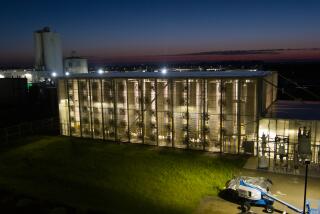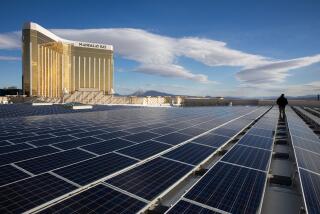Aviator Plots New Course Fueled by the Sun
LAKE ELSINORE, Calif. — Ever since 1903, when Orville Wright opened the throttle on the engine of his rickety biplane and soared briefly over the sand dunes of Kitty Hawk, N.C., aviation-crazy Americans have pushed relentlessly toward new milestones in their evolving quest to defy gravity and mingle with the clouds.
In 1927, Charles A. Lindbergh completed the first solo, nonstop transatlantic flight, remaining aloft in his monoplane, the Spirit of St. Louis, for 33 hours and 39 minutes. Twenty years later, a U.S. Air Force captain named Charles E. Yeager displayed a hearty dose of derring-do by piloting a rocket-powered research plane faster than the speed of sound.
Now comes Eric Raymond of Lake Elsinore. A slight fellow with wire-rimmed glasses and a boyish look, Raymond hopes to etch his name in aviation history this summer by harnessing the power of the sun to fly across the United States.
Raymond, 33, will attempt the transcontinental journey in a homemade craft dubbed the Sun-Seeker. The plane, a gangly specimen Raymond spent four years building in his cramped garage, is covered with 700 solar cells, which convert sunlight into electricity to charge a bank of batteries.
The batteries, in turn, drive a three-horsepower motor. Raymond uses the motor for takeoffs, for landings and as needed in turbulence, but mostly the Sun-Seeker rides “thermals”--updrafts of hot air--to gain altitude, and then just glides like a gull.
Raymond hopes to set off from Desert Center, east of Palm Springs, Friday morning. But rough weather already has ruined one stab at the historic flight, and the pilot says he will wait for a perfect forecast before leaving the ground again.
When he does ascend, Raymond will fly at altitudes up to 18,000 feet, while his wife, Aida, and a friend follow in a chase plane, and a ground crew trails the aviators with tools and other equipment. Raymond plans to chart a southerly course, pausing for the night at rural airports and making his final landing at Kitty Hawk. The trip is expected to take 10 days.
Raymond, a champion hang glider whose fascination with flight began in boyhood with model airplanes, is not the first to demonstrate the potential of solar-powered air travel. The Sun-Seeker builds on the work of Paul MacCready of Pasadena, who has constructed human-powered aircraft and designed the Solar Challenger, a plane that used the sun’s rays to cross the English Channel in the early 1980s.
About that time, Raymond began ruminating on the prospect of attempting a longer solar flight, motivated by reasons both personal--”it’s a lot of fun up there”--and public-spirited. The benefits of his flight--if successful--may not rank with those made by Wright or Yeager, but Raymond does believe he can illustrate the potential of energy-efficient travel--and spur an interest in sun-powered planes and even cars.
“I don’t like gasoline engines--they’re noisy and they pollute--and I want to show people the possibility of solar transportation,” Raymond explained one day recently as he studied a crack in one of the Sun-Seeker’s wings.
“I don’t foresee solar-powered airliners or jet fighters or anything, but we have the technology right now to design an aircraft that could fly 100 m.p.h. on solar power. People should be working on these things.”
In 1986, Raymond began building the Sun-Seeker. His father, an engineer, helped out, and Raymond said he also tapped the wisdom of several retired aeronautical engineers, who “saw the project as a fun way to spend some time.”
Materials and other expenses, however, were eating up the Raymonds’ savings, and at one point their bank account dipped below $100. Help came from Sanyo, which supplied the solar cells, and several other Japanese companies that have provided funding. In September, Raymond was able to close down his business designing and selling hang-gliding accessories and concentrate full time on his airplane.
Made of carbon fiber and high-density aircraft foam, the plane weighs just 195 pounds and balances during takeoff on a retractable bicycle wheel. Resembling a giant, exotic insect, it has a wingspan of 55 feet and a 23-foot-long fuselage with a propeller at the tail end. The tiny cockpit--just 21 inches wide--has a tinted cover of acrylic glass and is equipped with a radio and controls for the hydraulic brakes and motor.
Raymond says the craft travels at an average of 40 m.p.h., but he has reached speeds of 75 m.p.h. during more than 50 test flights over the desert in eastern Riverside County.
Earlier this month, Raymond got as far as Lordsburg, N.M., after two days in the air and set a pair of unofficial records for solar-powered flight--distance traveled and flying time. The pilot was forced to abandon the cross-country journey, however, when the Sun-Seeker’s wing was damaged during an aborted takeoff.
“It was a good trial run, but the weather was so bad it’s just as well we came back,” Raymond said, seemingly undiscouraged by the false start. “I know we’ll make it eventually.”
Until he lifts off again, Raymond will be tinkering with the Sun-Seeker in an industrial warehouse near the shores of Lake Elsinore--repairing the injured wing and trying to improve the craft’s climbing ability.
“I was having some trouble taking off at high altitude, so we’re going to adjust the pitch of the propeller and hope that helps,” Raymond said. “The U.S. has a big hill in the middle called the Continental Divide, and I’ve got to make it over that.”
Raymond, who has no doubt that he will complete the trek to Kitty Hawk, already has another aviation challenge simmering in the back of his mind. He wants to build a solar-powered airship.
“You know, like the Hindenburg,” Raymond explained. “It wouldn’t be nearly that big, but an airship would be easy to fly around the world.”
More to Read
Sign up for The Wild
We’ll help you find the best places to hike, bike and run, as well as the perfect silent spots for meditation and yoga.
You may occasionally receive promotional content from the Los Angeles Times.






